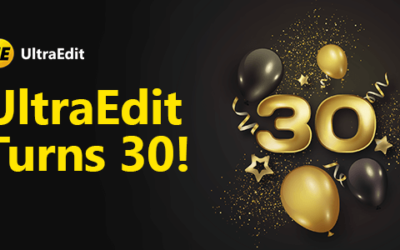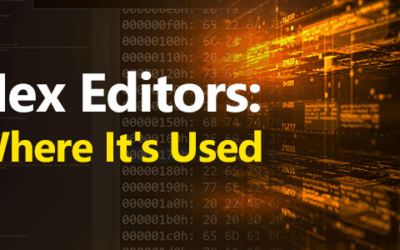In light of an ever-growing text editor market, we are constantly thinking of ways to make UltraEdit better. Our most recent release, which includes the oft-requested Markdown support, is one product of those efforts. So as of v25.20, UltraEdit includes full support for Markdown highlighting, editing, and previewing!
Coupled with our new live preview feature in UltraEdit v25.20, if you’re already writing Markdown documents you’ll be able to enjoy a real-time preview of your rendered Markdown as you make them in your source file. Additionally, we’ve added a completely new syntax parser for Markdown, so you’ll get full, context-aware Markdown code highlighting support out of the box. No plugins to download and install, no config files to set up. It just works—and that’s the way it should be.
Those of you who are already familiar with Markdown will understand why this is so exciting. But there are others among you who have heard of Markdown but have never used it, or who haven’t heard of it at all! So we wanted to talk about some of the reasons why Markdown is so great.
What Is It?
Markdown is a plain text formatting syntax aimed at making writing for the internet easier. The philosophy behind Markdown is that plain text documents should be readable without tags mussing everything up, but there should still be ways to add text modifiers like lists, bold, italics, etc. It is an alternative to WYSIWYG (what you see is what you get) editors, which use rich text that later gets converted to proper HTML.
It’s possible you’ve encountered Markdown without realizing it. Facebook chat, Skype, and Reddit all let you use different flavors of Markdown to format your messages.
Here’s a quick example: to make words bold using Markdown, you simply enclose them in * (asterisks). So, *bold word* would look like bold word when everything is said and done.
All told, Markdown is a great way to write for the web using plain text.
Why Use It?
It’s Easy to Learn and Fast to Use
Markdown is dead simple to learn. The official syntax can be found here, but most of what you’ll need to know is that typing **word** or __word__ will make it bold, typing *word* or _word_ will italicize the word, links are written like this [anchor text](http://www.URL.com), and lists are written exactly how you’d expect: just hit enter and add any of these three characters at the start of each line: -, *, +. So this:
– List item 1
– List item 2
– List item 3
Becomes this:
- List item 1
- List item 2
- List item 3
Or you could always use a tutorial to learn how to write Markdown, like this one.
So typing Markdown is almost always faster than writing with a rich text editor, especially when you start getting into things like links or bulleted lists, which either make you use the mouse or force you to memorize a complicated sequence of keyboard shortcuts. One caveat is that if you need complicated text elements, such as tables, you’re better off sticking to HTML. Fortunately, Markdown has full HTML support, so you can code a table in HTML and go right back to Markdown in the same document.
Plus, it’s much easier to read raw Markdown than it is to read raw HTML. Which, you know, was part of the reason Markdown was even invented.
It Converts to HTML Easily
Now, if you’re going to be writing HTML, you should just…write HTML. But if you’re, say, writing an email or a readme file where you need HTML’s formatting options but not the full breadth of its features, Markdown is perfect.
Markdown converts to HTML flawlessly, sparing you the hassle of opening and closing all those tags. So. Many. Tags.
In fact, Markdown has the software to convert the plain text to HTML built in! So Markdown is actually a text-to-HTML conversion software in addition to being a markup language.
Plus, have you ever tried to convert from a .docx file to HTML? You often get so much extra formatting and spacing that it’s not worth the effort.
Markdown is Futureproof
By “futureproof,” we mean that Markdown is a plain text format. For as long as plain text is the standard (which it will be for a long, long time), Markdown will be usable and openable by modern programs. Compare this to Microsoft Word, which has 8 different filetypes as of 2018. Keeping things plain text ensures there will never be an outdated version, so software doesn’t need to update to keep up with the format.
Markdown does have its own filename extension: .md, but it was designed to be perfectly readable as a raw text file. So it’s safe to say that Markdown isn’t going anywhere.
It’s Used Everywhere
You might expect that Markdown’s use has stalled as rich text becomes more and more popular, but that’s actually incorrect. Markdown’s presence has only grown since its introduction, and it continues to do so.
Markdown is the unofficial standard on popular coding sites such as GitHub. It is also the default formatting option for popular communication tools such as Skype, Slack, and (to a lesser extent) Facebook Messenger. Wikipedia even uses a modified Markdown syntax they call wikitext.
In a world of social coding that’s only becoming more social, the programmer who doesn’t know Markdown will find themselves at a disadvantage (or, at the very least, confused for a little while).
So learn Markdown, if for no other reason than so you can keep up with the industry.
You Don’t Have to Switch Editors to Write Prose
Writing prose has always been something of a challenge using text editors. It isn’t as though it can’t be done, but plain text removes a lot of the formatting options that tend to come in handy when writing prose. This is more of a small inconvenience than a big issue, but it’s still enough that many people would rather switch to their email program to write an email or their word processor to write prose, as opposed to staying in UltraEdit and writing everything there. But with the introduction of Markdown, writing an email or blog within UltraEdit is now a perfectly viable way to proceed. Of course, you don’t have to do that, but giving people options for how to handle each situation is one of the things UltraEdit does best!
Try UltraEdit Today!
If you haven’t tried UltraEdit yet, give it a shot. Its commercial support, world-class security, and generous 30 day money back guarantee are just a few of the reasons why UltraEdit has been going strong for 25 years. With it’s new Markdown support features, there is even more to love.
Plus, you can try it completely free for 30 days!





0 Comments